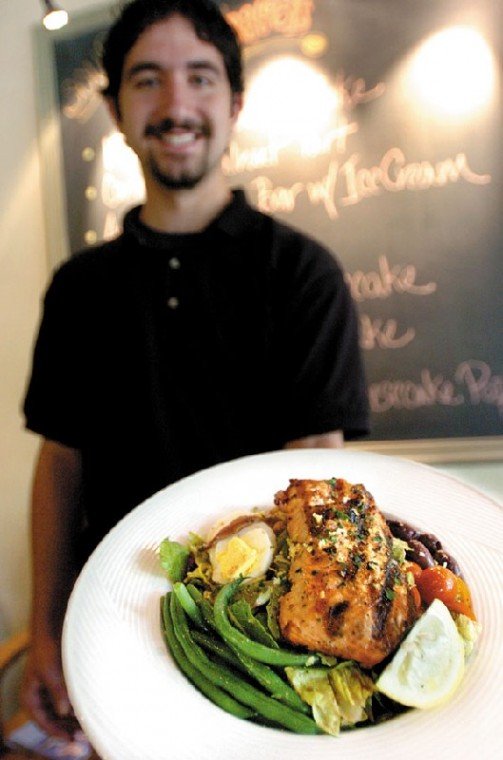There it is, written right there on the menu. It’s mocking you.
It seems to be saying,
”
Ooooh, don’t you feel stupid?
”
And you do. Because it’s some sort of food term and you have no
idea what it means.
There it is, written right there on the menu. It’s mocking you. It seems to be saying, “Ooooh, don’t you feel stupid?” And you do. Because it’s some sort of food term and you have no idea what it means.
Though many people have no problem simply asking their server to clarify how various dishes on a menu are prepared, we decided to ask local restaurants about some food terms that appear on their menus that may not be common knowledge. Whether you want to impress a date or you just want to avoid that “I feel dumb” moment, here’s the skinny on a few confusing menu items.
Sate/Satay
Originally an Indonesian dish, satay typically consists of small marinated pieces of meat or fish on skewers that are grilled or broiled. Stubby’s Sports Bar & Grill in Gilroy serves peanut chicken sate, which is marinated chicken pieces on a skewer, grilled and served with a spicy peanut sauce, said co-owner John Stieber. Also, Ayuttaya Cuisine on First Street prepares several authentic satay dishes.
Coulis (Coo-lee)
A coulis is a type of sauce and can be either sweet or savory. It’s finely blended, and can have a base of fruit, cream or vegetables, said Carlos Ruiz, executive chef at The Inn at Tres Pinos restaurant. The Inn serves a grilled portobello mushroom pizza that’s topped with portobello, fresh roma tomatoes, basil coulis and melted mozzarella cheese.
Bruschetta (Brew-shet-ta)
The name of this dish is from the Italian bruscare meaning “to roast over coals.” Traditionally, garlic bread is made by rubbing slices of toasted bread with garlic cloves, then drizzling the bread with extra-virgin olive oil. The bread is salted and peppered, then heated and served warm. Many modern versions top the garlic bread with fresh tomatoes, herbs and cheese, then serve after quickly broiling the dish. Bruschetta is a popular appetizer at Giancarlo’s in Morgan Hill.
Source: www.epicurious.com/cooking/how_to/food_dictionary/
Nicoise (Nee-swa)
This term comes from a French phrase that means “as prepared in Nice.” The style of preparing foods is typical of many dishes found in the French Riviera, often including olives, tomatoes, garlic, anchovies, hard-boiled eggs, green beans and other herbs. Many restaurants serve tuna nicoise style, but Ragoots in Morgan Hill serves a salmon nicoise salad.
Clafouti (Kla-foo-tee)
This is a French country dessert made by topping a layer of fresh fruit with batter. After baking the dish, it’s served hot, sometimes with cream. Some clafoutis have a cake-like topping while others are more like pudding. Though cherries are traditional, any fruit can be used.
Source: www.epicurious.com/cooking/how_to/food_dictionary/
Carpaccio (Car-pah-chee-o)
This is high-quality beef that’s served cold and very rare. Sometimes it’s quickly seared on the outside, but it’s traditionally served raw and sliced extremely thin. It’s a delicate dish that’s very popular, said Darlene Guevara, manager of the Golden Oak restaurant in Morgan Hill, which serves the dish. At the Golden Oak, carpaccio comes with capers, spicy mustard and red onions that can be mixed and spread on top.
Gazpacho (Gauze-paw-cho)
A refreshingly cold, summertime soup hailing from southern Spain. This uncooked soup is usually made from a pureed mixture of fresh tomatoes, sweet bell peppers, onions, celery, cucumber, bread crumbs, garlic, olive oil, vinegar and sometimes lemon juice. Extra fresh vegetables such as sliced celery, green onion, cucumber and green pepper are often added to bulk up the dish. Popular garnishes include croutons and diced hard-cooked eggs.
Source: www.epicurious.com/cooking/how_to/food_dictionary/
Remoulade (Ray-moo-laud)
This is a French sauce, often used as a dip or spread accompanying cold meats, fish or shellfish. It’s typically made with mayonnaise or a cream base, mustard, capers, chopped gherkins, herbs and anchovies, though ingredients often vary from restaurant to restaurant. Rosy’s at the Beach serves a spicy remoulade with their crab cakes and people often request it with their fried calamari, said restaurant owner Rosy Bergin.
Aioli (Ay-o-lee)
This sauce is generally made from garlic, egg, lemon juice or vinegar and olive oil. Many explain it as a flavored mayonnaise, though there are many variations to the ingredients. Ragoots in Morgan Hill serves garlic aioli on several sandwiches.
Julienne
This term can be used as a noun or a verb. As a noun, it means foods that have been cut into thin, matchstick strips. Length does not matter. As a verb, it means to cut the food into very thin strips.
Source: www.epicurious.com/cooking/how_to/food_dictionary/













